
James Charles (1851-1906) stands as a significant, if sometimes overlooked, figure in the landscape of British art during the late Victorian and Edwardian eras. An artist deeply attuned to the nuances of the natural world and the quiet dignity of rural existence, Charles carved out a distinct niche for himself. His work, primarily characterized by its sensitive handling of light and atmosphere, reflects the broader currents of Impressionism and plein air painting that were transforming European art, yet it retains a uniquely British sensibility. This exploration delves into the life, artistic development, key works, and contextual significance of James Charles, a painter whose canvases continue to resonate with their gentle observations and luminous beauty.
Early Life and Artistic Foundations
James Charles was born in Warrington, Lancashire, in 1851. His familial roots, however, traced back to France, with his family having been settled for some time in Caernarfon, Wales. This connection to Wales, and perhaps a lingering French heritage, may have subtly informed his later artistic openness to continental influences. His father, Richard Charles, was a man of practical artistic skill, working as a draughtsman and cabinet maker. Notably, Richard Charles was responsible for designing the mayor's office in Caernarfon, suggesting a household where design and aesthetics were valued.
At the age of fourteen, a pivotal move occurred when James accompanied his father to London. Initially, he worked in his father's office, a period during which he received what has been described as a somewhat scattered education. However, the artistic pulse of the capital evidently stirred a deeper calling within him. The young Charles soon embarked on a formal artistic education, a path that would shape his technical abilities and aesthetic inclinations.
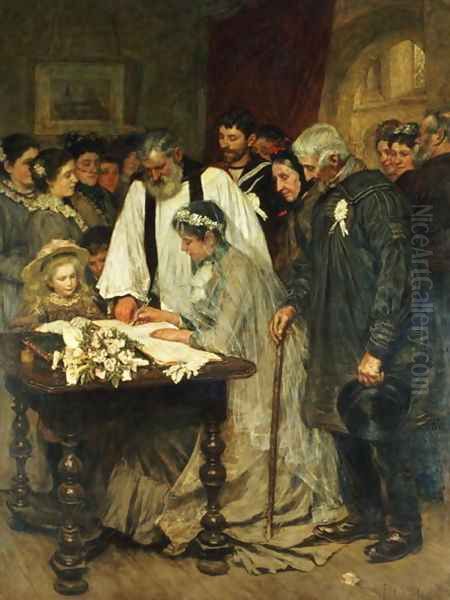
His initial training took place at the Heatherley School of Fine Art in London, an independent art school known for its less rigid approach compared to the Royal Academy, allowing students more freedom to develop their individual styles. Heatherley's had a reputation for attracting aspiring artists who sought a more bohemian and progressive environment. Following his time there, Charles progressed to the prestigious Royal Academy Schools. Here, he would have been immersed in a more traditional academic curriculum, focusing on drawing from the antique and the live model, composition, and the techniques of the Old Masters. It was at the Royal Academy that he began to exhibit, marking his entry into the professional art world.
A crucial phase in his development was his time spent in Paris, where he studied at the Académie Julian. This private art school was a popular destination for international students, including many Americans and Britons, who sought an alternative or supplement to the more conservative École des Beaux-Arts. At Julian's, students benefited from the tutelage of prominent academic painters, but the environment was also a crucible for new ideas. It was during his time in France, and through his experiences there, that Charles became profoundly influenced by the burgeoning "plein air" (open-air) painting movement. This approach, central to Impressionism, emphasized painting outdoors to capture the fleeting effects of light and atmosphere directly.
The Embrace of Impressionism and Plein Air Principles
The influence of French Impressionism and the practice of plein air painting became hallmarks of James Charles's mature style. While British art had its own strong landscape tradition, notably through figures like John Constable and J.M.W. Turner who had long valued direct observation of nature, the French Impressionists took this to a new level with their emphasis on broken brushwork, a brighter palette, and the depiction of subjective visual sensations.
Charles was particularly drawn to capturing natural light. His canvases often explore the interplay of sunlight and shadow, the subtle shifts in colour temperature throughout the day, and the atmospheric conditions of the English countryside. He was less concerned with the radical dissolution of form seen in some French Impressionists like Claude Monet in his later period, and more aligned with painters who balanced Impressionistic techniques with a degree of naturalistic representation, such as Camille Pissarro or Alfred Sisley, or indeed, the French rural naturalist Jules Bastien-Lepage, whose influence was pervasive among many British artists of this generation.
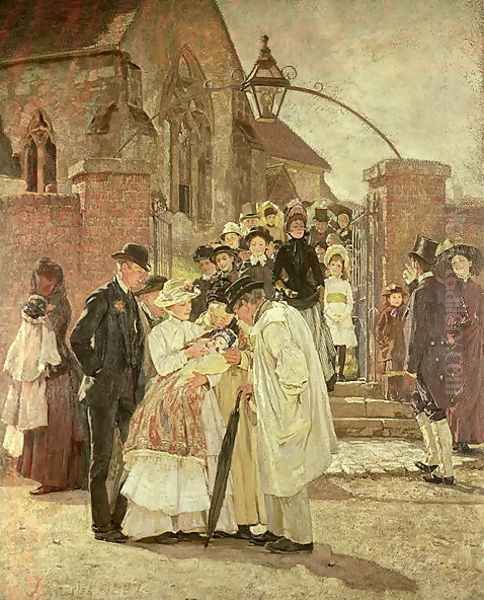
His commitment to painting outdoors, or at least making extensive outdoor studies, allowed him to imbue his landscapes and genre scenes with a sense of immediacy and authenticity. This was a departure from the studio-bound practices of many academic painters who often constructed their landscapes from sketches and memory. Charles's dedication to observing and rendering the specific qualities of light in different settings – the dappled sunlight through trees, the soft glow of an overcast day, or the warm light of late afternoon – became a defining characteristic of his work.
Themes and Subjects: The English Countryside and Its People
James Charles's oeuvre is predominantly focused on landscapes, rural genre scenes, and portraits, though he is best known for the first two. His subject matter was largely drawn from the southern English countryside, particularly areas around Blandford in Dorset and later, extensively in Sussex. He developed a deep affinity for these regions, eventually choosing to live near the places that inspired his art.
His landscapes are rarely empty vistas; they are often populated, or show evidence of human activity, reflecting a gentle humanism. He depicted farm workers, children at play, quiet village streets, and agricultural activities. These were not grand historical or mythological narratives, but rather intimate portrayals of everyday life. In this, he shared common ground with other British artists of the period who were turning away from overtly literary or moralizing subjects towards a more direct engagement with contemporary rural life, sometimes referred to as British Impressionism or Social Realism, depending on the emphasis.
Painters like George Clausen and Henry Herbert La Thangue were also exploring similar themes of rural labour and landscape, influenced by French plein air naturalism. The artists of the Newlyn School in Cornwall, such as Stanhope Forbes and Frank Bramley, were also committed to depicting the lives of ordinary working people in a naturalistic, open-air style. While Charles may not have been formally part of a specific "school," his artistic concerns and methods aligned him with this broader movement in British art that sought authenticity and a fresh engagement with the visible world.
Notable Works: A Closer Look
Several paintings stand out in James Charles's body of work, showcasing his skill and artistic vision.
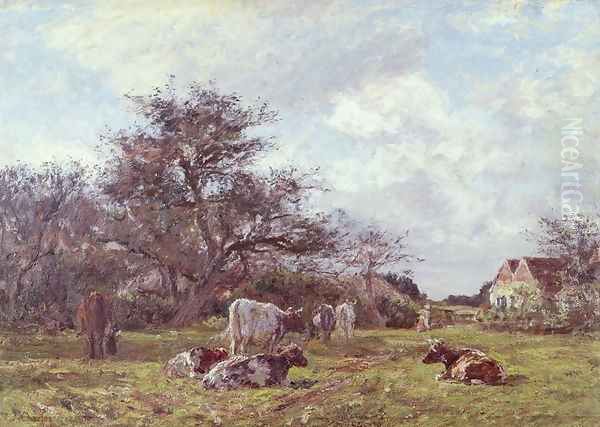
Signing the Marriage Register (exhibited Royal Academy, 1895; now in Cartwright Hall Art Gallery, Bradford) is one of his most recognized genre paintings. It depicts a scene inside a simple room, likely a vestry or a cottage, where a young couple is formalizing their marriage. The figures are rendered with a quiet naturalism, and the painting offers a piece of social observation, capturing a significant moment in the lives of ordinary rural people. The light, likely from a nearby window, is handled with subtlety, illuminating the figures and the modest interior. The work demonstrates Charles's ability to combine narrative interest with his painterly concerns for light and atmosphere.
Christening Sunday (1887; Manchester Art Gallery) is another significant genre scene, painted in South Harting, near Petersfield in Sussex. It portrays a group of figures, dressed in their Sunday best, gathered outside a church, presumably after a christening ceremony. The painting captures a communal moment, with varied individuals and family groups. The composition is natural and unforced, and the figures are individualized. Charles's interest in the effects of outdoor light is evident in the way the sunlight falls on the figures and the church building. This work is often considered to lean towards a Realist depiction, emphasizing the social fabric of village life.
Will it Rain? (Tate Gallery) is a testament to Charles's skill in landscape painting and his ability to capture a specific mood and atmospheric condition. The title itself points to the artist's preoccupation with the changeable English weather. Such a work would have relied heavily on direct observation and a swift, responsive painting technique to capture the fleeting effects of light and cloud before the weather turned.
On a Sussex Farm (1904) exemplifies his Impressionistic landscapes. This work would likely feature the characteristic broken brushwork and attention to the play of light across fields, trees, and farm buildings, conveying the tranquility and pastoral beauty of the Sussex countryside that he came to love. His depiction of green foliage and scattered trees would be rendered with a keen eye for naturalistic detail, filtered through an Impressionist sensibility.
Milking Time is another example of his engagement with rural themes, depicting a common agricultural activity. Such paintings often combined animal painting with landscape and genre elements, showcasing the harmonious relationship between humans, animals, and the land. The "sunshine on cattle" aspect noted in some descriptions points to his continued fascination with light effects.
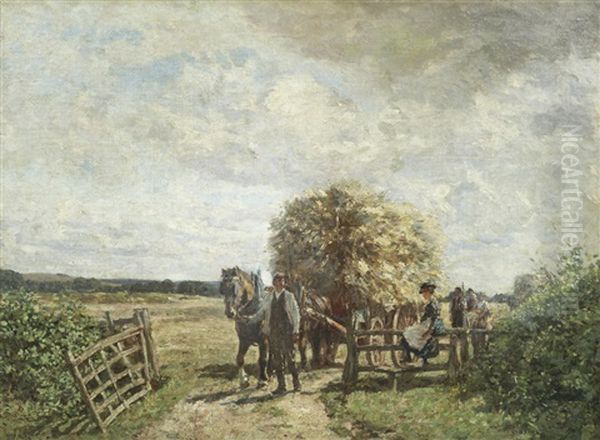
The Village Post Office (Johannesburg Art Gallery) and The Lost Hat (purchased by the notable collector George McCulloch, who also patronized artists like John William Waterhouse and Lord Leighton) further illustrate his range, from intimate village scenes to evocative landscapes that often included a subtle narrative or human element. His pencil drawings, such as those in Studies of Landscapes and Figures (1902), reveal his foundational skill in draughtsmanship, underpinning his painted works.
Exhibitions, Recognition, and Artistic Milieu
James Charles achieved a notable degree of success and recognition during his lifetime. He exhibited regularly at major London venues, including the Royal Academy, the Grosvenor Gallery (a more progressive alternative to the RA, favoured by artists like James McNeill Whistler and Edward Burne-Jones), and the New English Art Club (NEAC). The NEAC, founded in 1886, was a particularly important exhibiting society for artists influenced by French Impressionism and plein air painting, providing a platform for those who felt constrained by the conservatism of the Royal Academy. His involvement with the NEAC places him firmly within the circle of avant-garde British painters of his time.
His work was not confined to Britain; he also exhibited in Paris, a testament to his connections with the French art world and the international appeal of his style. A significant accolade was the silver medal he received at the Paris International Exhibition (Exposition Universelle) of 1889. This event was a major showcase of art and industry, and receiving an award there was a mark of considerable distinction. He also became an associate of the Société Nationale des Beaux-Arts in Paris, further cementing his reputation on the continent.
The late 19th and early 20th centuries were a dynamic period in British art. While Victorian academicism, with its emphasis on historical subjects, meticulous finish, and moral narratives (exemplified by artists like Lord Leighton and Sir Lawrence Alma-Tadema), still held considerable sway, new movements were gaining traction. The legacy of the Pre-Raphaelites continued, and the Aesthetic Movement championed "art for art's sake." Against this backdrop, the rise of British Impressionism, or "Anglo-French" painting as it was sometimes called, represented a significant shift.
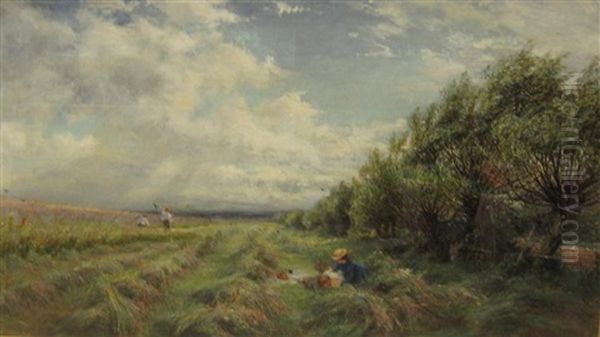
Artists like Philip Wilson Steer, a leading figure in British Impressionism, and Walter Sickert, with his more urban and psychologically charged subjects, were key contemporaries. While Sickert's focus was often the gritty realism of city life, Steer, like Charles, often painted landscapes and coastal scenes with a distinctly Impressionistic flair. The Glasgow Boys, a group of Scottish painters including James Guthrie and John Lavery, were also working in a similar vein, influenced by French realism and Impressionism, and dedicated to modern subjects and techniques.
Charles's work, with its focus on rural England, can be seen as part of a broader interest in national identity and the countryside that was prevalent at the time. As Britain became increasingly industrialized and urbanized, there was a corresponding nostalgia and artistic interest in preserving and celebrating the perceived simplicity and authenticity of rural life. His paintings, however, generally avoided overt sentimentality, focusing instead on the quiet dignity of his subjects and the beauty of their surroundings.
Later Years and Legacy
In his later years, James Charles chose to settle in East Ashling, near Chichester in Sussex, close to the landscapes that had become so central to his art. This decision reflects a common pattern among landscape painters who immerse themselves in a particular environment to better understand and depict its unique qualities. He continued to paint prolifically, refining his approach to capturing the light and atmosphere of the South Downs and the surrounding countryside.
Tragically, James Charles's life was cut short. He died in 1906 at the relatively young age of 55 from appendicitis, an illness that was often fatal in the pre-antibiotic era. His death occurred while he was still actively painting and exhibiting, leaving a sense of unfulfilled potential.
Despite his contemporary success, James Charles's name is perhaps not as widely known today as some of his peers like Steer or Sickert. This may be due in part to the quiet, unassuming nature of his art, which eschewed grand statements or radical provocations. However, his contribution to British painting is significant. He was a dedicated and skilled practitioner of plein air painting and an important conduit for Impressionistic ideas in Britain.
His works are held in numerous public collections, including the Tate Britain, Manchester Art Gallery, Cartwright Hall Art Gallery in Bradford, and the Johannesburg Art Gallery, ensuring that his art remains accessible to the public. His paintings offer a gentle, luminous window onto late Victorian and Edwardian rural England, capturing a way of life that was already beginning to change.
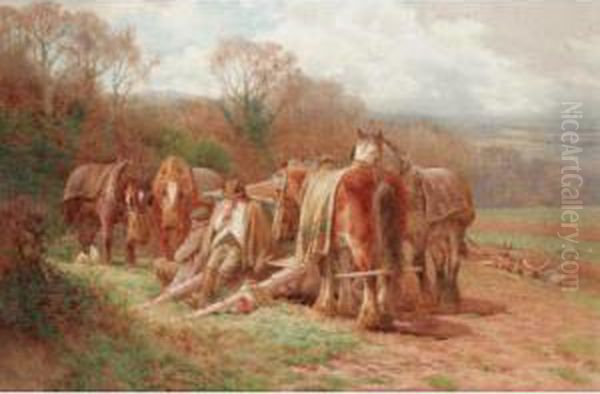
In the broader context of art history, James Charles can be seen as an artist who successfully synthesized continental innovations with a deeply felt connection to his native landscape and its people. He stands alongside other notable British painters of his generation, such as Stanhope Forbes, Frank Bramley, George Clausen, H.H. La Thangue, and even the slightly younger Harold Knight and Laura Knight (who were beginning their careers as Charles's was ending), all of whom contributed to a vibrant period of naturalistic and Impressionist-influenced art in Britain. His dedication to capturing the truth of visual experience, particularly the ephemeral qualities of light, ensures his enduring appeal and his place in the story of British art. His legacy is one of quiet beauty, technical proficiency, and a heartfelt engagement with the world around him.